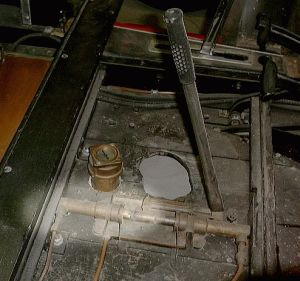The hand fuel pump is a simple
construction of a piston within a cast bronze cylinder housing. There are no
check valves incorporated in the hand fuel pumpís housing. Operation of the
hand fuel pump relies on two check valves installed at strategic locations
within the fuel system plumbing. A check valve in the fuel supply line near
the fuel tank (fuel supply check valve), and a second check valve after the
fuel pump (power fuel pump check valve), provides the necessary valve action
for proper operation of the hand fuel pump.
When the pump handle is moved such
that the hand fuel pumpís piston is pulled out of the hand fuel pumpís
cylinder, fuel is sucked out of the fuel supply tank at the rear of the car and into the space once
occupied by the piston. The power fuel pumpís internal check valves along
with the check valve that is located past the power fuel pump insure that
fuel is not sucked out of the fuel pressure tanks and back into the hand fuel
pumpís cylinder as the piston is moved.
When the pump handle is moved such
that the hand fuel pumpís piston is pushed back into the hand fuel pumpís
cylinder (i.e. the pump handle is pulled towards the front passenger seat), the fuel in the cylinder and piping connected to the hand fuel
pumpís cylinder is pressurized. The check valve just after the fuel tank now
closes and stops the fuel from flowing back into the supply tank. However,
as the hand fuel pumpís piston continues to be moved into the hand fuel
pumpís cylinder, pressure builds in the piping between the fuel supply check
valve and the power fuel pump check valve. When the fuel pressure within the
piping becomes greater than the pressure of the fuel in the burner fuel
pressure tanks, the power fuel pump check valve opens and allows the fuel to
flow into the burner fuel pressure tanks. At the end of the stroke the check
valve just past the power fuel pump closes to maintain the fuel at the
pressure it is at within the burner fuel pressure tanks.
